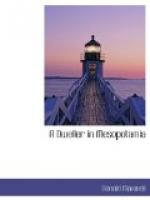From many delightful points of view the gleaming towers of this place, seen through the palms and reflected in the flooded lagoons at the margin of the river, do indeed give us something of the colour and romance that we had expected to see and yet so rarely find in the sun-baked lands of Mesopotamia.
[Illustration]
VIII
PARADISE LOST
[Illustration: “Blossoms and fruit at once of golden hue Appeared, with gay enamelled colours mixed.” —Paradise Lost, IV.]
[Illustration]
PARADISE LOST
The statement often made that Mesopotamia is a vast desert through which run two great rivers, bare but for the palm trees on their banks and flat as a pancake, is true as far as it goes. It is possible, however, to picture a land entirely different from Mesopotamia and still stick to this description. I have met countless men out there who have told me that they had built up in their minds a wrong conception of the country and a wrong idea of its character simply by letting their imagination get to work on insufficient data.
To begin with, the word “desert” generally suggests sand. People who have been to Egypt or seen the Sahara naturally picture a sandy waste with its accompanying oases, palms and camels. Mesopotamia, however, is a land of clay, of mud, uncompromising mud. The Thames and Medway saltings at high tide, stretching away to infinity in every direction—this is the picture that I carry in my mind of the riverside country between Basra and Amara. No blue, limpid waters by Baghdad’s shrines of fretted gold, but pea-soup or cafe au lait. Even the churned foam from a paddle wheel is cafe au lait with what a blue-jacket contemptuously referred to as “a little more of the au lait!” At a distance it can be blue, gloriously blue, by reflection from the sky, but it will not bear close examination.
The railway skirts the river here, running from Ezra Tomb to Amara having started from Basra. Amara must not be confused with Kut-el-Amara. The names are a source of great confusion to newcomers. When I was told that the railway did not go any further than Amara, I lightheartedly pictured myself making my way across the river in a goufa or bellam and scorned the suggestion that I might have to wait some time for a steamer to Kut. I thought Kut was on one side of the river and Amara on the other. It is, however, a twenty-four hours’ journey in a fast boat.
It is perfectly true that the country is “as flat as a pancake” in original formation, but the traces of ancient irrigation systems, to say nothing of buried cities—Babylon is quite mountainous for Mesopotamia—make it a very bumpy plain in places.
[Illustration: DAWN AT AMARA]




